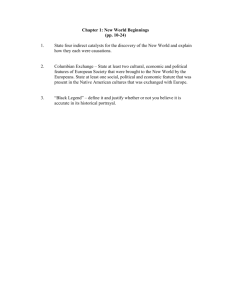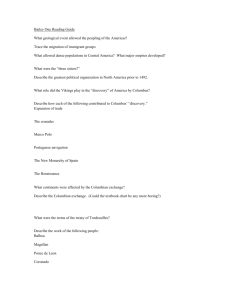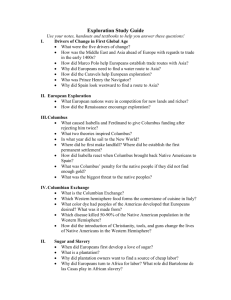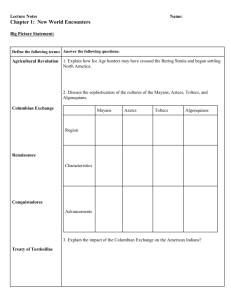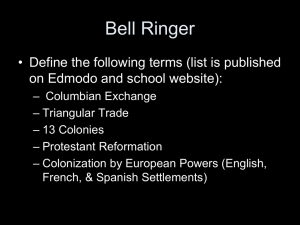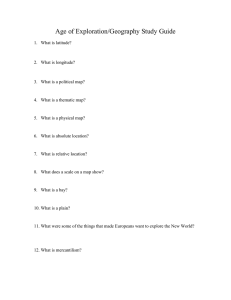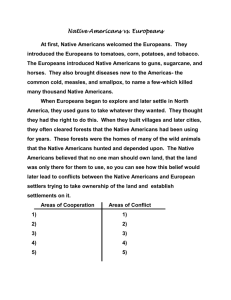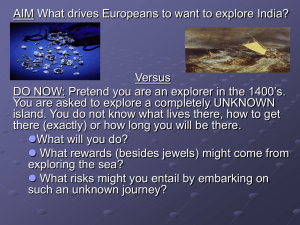New World
advertisement
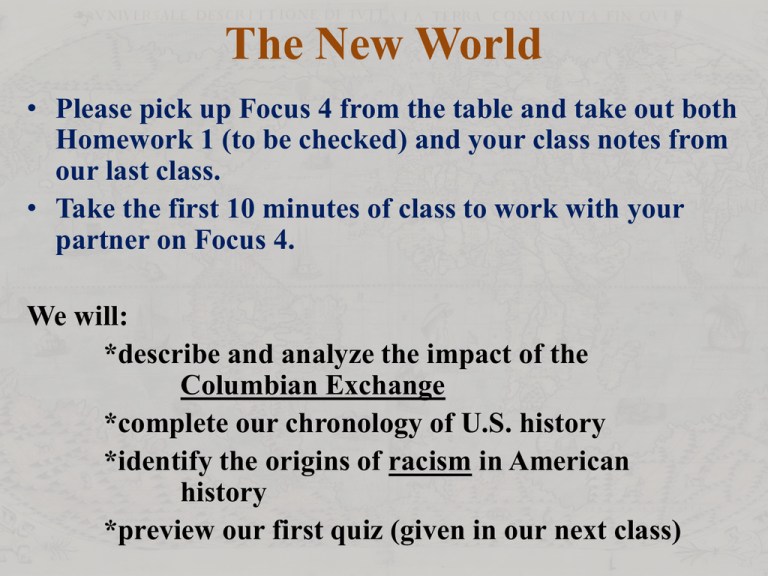
The New World • Please pick up Focus 4 from the table and take out both Homework 1 (to be checked) and your class notes from our last class. • Take the first 10 minutes of class to work with your partner on Focus 4. We will: *describe and analyze the impact of the Columbian Exchange *complete our chronology of U.S. history *identify the origins of racism in American history *preview our first quiz (given in our next class) The New World Three Worlds Meet: Europe, Africa, & the Americas The Columbian Exchange • 1492: Discovery of the New World by Italian explorer Christopher Columbus ushered in modern world history • The Columbian Exchange represented a massive transfer of plants, animals, diseases, people, and cultures between the Old and New Worlds • By the 1700s, the entire globe was connected through trade • Western European nation-states such as Spain, Portugal, England, France, and the Netherlands dominated and profited from this new global system The Columbian Exchange What motivated Europeans to explore and colonize the New World? • Western Europeans sought more direct routes to obtain Oriental luxury goods such as silks and spices from China and India • Italian and Middle Eastern Muslim merchants dominated EastWest trade through the Mediterranean by the 1400s; Western Europeans sought to get around these “middlemen” • The Maritime Revolution, started by Portugal in the early 1400s, provided Europeans with the navigational technology that made ocean-going exploration possible caravel compass astrolabe What did Europeans gain? • New colonies in the Americas that served as the foundation of global commercial empires • Trade goods that provided new sources of wealth (gold and silver) and food (potatoes and corn) • An outlet for excess population • Spread of European culture, including religion, to the New World New World colonies by 1763 How were Native Americans affected? • Collapse of the Aztec and Inca empires at the hands of Spanish conquistadors (Cortez and Pizarro) by the 1530s • The Spanish enslaved Native Americans to work in mines and on encomiendas (large agricultural estates) • Many Native Americans were forcibly converted to Roman Catholicism and European language/customs • By 1600, nearly 90% of the Native American population perished as a result of a devastating smallpox epidemic, against which Native Americans had no natural defenses Left: Mural depiction of Cortez meeting the Aztec leadership Right: Photo and illustration of smallpox victims How were Africans affected? • As Native Americans perished, Europeans looked for a new and cheap source of labor and found it in the form of the Atlantic slave trade • Europeans traded rum and guns for slaves, taking them across the Atlantic via the infamous Middle Passage • Over 10 million slaves were brought to the New World from the 1500s to the 1800s (10 million more likely died on the voyage) • Slaves worked mostly on plantations that grew cash crops like sugar and tobacco What made all of this possible? • Jared Diamond’s Guns, Germs, and Steel makes the case that European domination of the New World and modern history was the result of geography and biology, NOT because of presumed European racial superiority • Western Europeans benefitted from trade with Asia, which gave them an advantage in technology and exposed them to deadly diseases carried by domesticated livestock and poultry • Native American and African cultures remained relatively isolated because of geographic barriers such as deserts and jungles and Native Americans had no resistance to Old World diseases Eurasians had a geographic advantage because of living along an East-West axis with similar climate and few geographic barriers How did racism emerge from the Columbian Exchange? By the mid-1500s, Spaniards portrayed Native Americans as less than human: Now compare these natural qualities of judgment, talent, magnanimity, temperance, humanity, and religion [of the Spanish] with those of these pitiful men [the Indians], in whom you will scarcely find any vestiges of humanness. These people possess neither science nor even an alphabet, nor do they preserve any monuments of their history…, nor do they have written laws, but barbarous institutions and customs. In regard to their virtues, how much restraint or gentleness are you to expect of men who are devoted to all kinds of intemperate acts and abominable lewdness, including the eating of human flesh? And you must realize that prior to the arrival of the Christians, … they made war against one another continually and fiercely, with such fury that victory was of no meaning if they did not satiate their monstrous hunger with the flesh of their enemies. ...These Indians are so cowardly and timid that they could scarcely resist the mere presence of our soldiers. Many times thousands upon thousands of them scattered, fleeing like women before a very few Spaniards. . . --Juan de Sepulveda (1547) http://www.digitalhistory.uh.edu/learning_history/spain/spain_sepulveda.cfm Columbus – Hero or Invader? • Should Columbus be celebrated as a hero for his discovery of the New World or should he be remembered as setting in motion the eventual destruction of Native American societies? • A Native American perspective: http://www.youtube.com/watch?v=_eCERkVpFPM • Read the full text of S.J. Res. 14 (April 30, 2009): http://thomas.loc.gov/cgi-bin/query/z?c111:S.J.RES.14: • “To dignify Columbus and his legacy with parades, holidays, and other celebrations is repugnant. As the original peoples of this land, we cannot, and we will not, tolerate social and political festivities that celebrate our genocide. We are committed to the active, open, and public rejection of disrespect and racism in its various forms—including Columbus Day and Columbus Day parades.” --Open Letter from the American Indian Movement; October 8, 1994 What is the perspective of the cartoon with regard to today’s subject? “Reclaim America” by Steve Kelley for the San Diego Union Tribune (1994) Another perspective… European Empires in the New World Nationality? __________________ __________________ _____________________ Location South & Central America; California and Florida Quebec, Great Lakes, & Mississippi Valley Virginia, New England (Atlantic seaboard) Motives *wealth (“gold”) *expansion of Roman Catholicism (“God”) *personal adventure and advancement (“glory”) *wealth *expansion of Roman Catholicism *wealth *religious freedom *economic opportunity for colonists Economy & Society *mining of silver/gold *large agricultural estates (encomiendas) *hierarchical social system with Europeans at the top and mestizos and slaves at the bottom *fur trade with Native Americans *limited farming *small population dominated by landowners *agriculture – both large plantations and small family farms *timber and fishing *growing population with concentration of slaves in the Southern colonies Relations with Native Americans *treated them as less than *treated them as equals equal; often enslaved and and sought to convert forcibly converted them them peacefully *sought to cooperate with them to survive but also fought with them when they became an obstacle to growth Before we leave… • Remember to review for our first quiz on the material in Chapter 1 and U.S. geography - focus on physical features, regions, and major cities and use the quiz preview as a guide • Complete Homework 2 for next class • If you have a U.S. map to turn in today, keep it to study for the quiz – you can turn it in for credit just before you take the quiz at the start of our next class.
